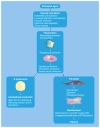Biomarkers in systemic sclerosis
- PMID: 20387310
- PMCID: PMC3049114
- DOI: 10.2217/bmm.09.79
Biomarkers in systemic sclerosis
Abstract
Systemic sclerosis is an autoimmune inflammatory disorder of unknown etiologycharacterized b y pronounced fibroproliferative alterations in the microvasculature, and frequent cellular and humoral immunity abnormalities, culminating in a severe and often progressive fibrotic process. Numerous biomarkers reflecting the three main pathogenetic mechanisms in systemic sclerosis have been described; however, aside from several disease-specific autoantibodies, other biomarkers have not been thoroughly validated and require further study. Thus, there is an unmet need for validated biomarkers for diagnosis, disease classification, and evaluation of organ involvement and therapeutic response in systemic sclerosis.
Figures


Similar articles
-
An update on biomarker discovery and use in systemic sclerosis.Expert Rev Mol Diagn. 2017 Sep;17(9):823-833. doi: 10.1080/14737159.2017.1356722. Epub 2017 Jul 25. Expert Rev Mol Diagn. 2017. PMID: 28730919 Review.
-
[Pulmonary fibrosis and systemic sclerosis].Pneumoftiziologia. 1997 Oct-Dec;46(4):267-83. Pneumoftiziologia. 1997. PMID: 9654967 Review. Romanian. No abstract available.
-
Microparticles in systemic sclerosis: Potential pro-inflammatory mediators and pulmonary hypertension biomarkers.Respirology. 2019 Jul;24(7):675-683. doi: 10.1111/resp.13500. Epub 2019 Feb 12. Respirology. 2019. PMID: 30747487 Free PMC article.
-
[Progressive systemic sclerosis].Ryoikibetsu Shokogun Shirizu. 1994;(4):537-9. Ryoikibetsu Shokogun Shirizu. 1994. PMID: 8007234 Review. Japanese. No abstract available.
-
A review of recent studies on the pathogenesis of Systemic Sclerosis: focus on fibrosis pathways.Front Immunol. 2025 Apr 16;16:1551911. doi: 10.3389/fimmu.2025.1551911. eCollection 2025. Front Immunol. 2025. PMID: 40308583 Free PMC article. Review.
Cited by
-
Recognizing systemic sclerosis: comparative analysis of various sets of classification criteria.Reumatologia. 2016;54(6):296-305. doi: 10.5114/reum.2016.64906. Epub 2016 Dec 30. Reumatologia. 2016. PMID: 28115780 Free PMC article. Review.
-
Perspective to precision medicine in scleroderma.Front Immunol. 2024 Jan 18;14:1298665. doi: 10.3389/fimmu.2023.1298665. eCollection 2023. Front Immunol. 2024. PMID: 38304250 Free PMC article.
-
Rapid, noninvasive quantitation of skin disease in systemic sclerosis using optical coherence elastography.J Biomed Opt. 2016 Apr 30;21(4):46002. doi: 10.1117/1.JBO.21.4.046002. J Biomed Opt. 2016. PMID: 27048877 Free PMC article.
-
Comparative transcriptomic analysis validates iPSC derived in-vitro progressive fibrosis model as a screening tool for drug discovery and development in systemic sclerosis.Sci Rep. 2024 Oct 18;14(1):24428. doi: 10.1038/s41598-024-74610-2. Sci Rep. 2024. PMID: 39424619 Free PMC article.
-
Sclerotic-type chronic GVHD of the skin: clinical risk factors, laboratory markers, and burden of disease.Blood. 2011 Oct 13;118(15):4250-7. doi: 10.1182/blood-2011-04-350249. Epub 2011 Jul 26. Blood. 2011. PMID: 21791415 Free PMC article. Clinical Trial.
References
-
- Gabrielli A, Avvedimento EV, Krieg T. Scleroderma. N Engl J Med. 2009;360:1989–2003. - PubMed
-
- Bolster MB, Silver RM. Clinical features of systemic sclerosis. In: Hochberg MC, Silman AJ, Smolen JS, Weinblatt ME, Weisman MH, editors. Rheumatology. Mosby Elsevier; Philadelphia, PA, USA: 2008. pp. 1375–1385.
-
- Jimenez SA, Derk CT. Following the molecular pathways toward an understanding of the pathogenesis of systemic sclerosis. Ann Int Med. 2004;140:37–50. - PubMed
-
- Medsger TA., Jr Natural history of systemic sclerosis and the assessment of disease activity, severity, functional status, and psychologic well-being. Rheum Dis Clin North Am. 2003;29:255–273. - PubMed
Publication types
MeSH terms
Substances
Grants and funding
LinkOut - more resources
Full Text Sources
Other Literature Sources
Medical
